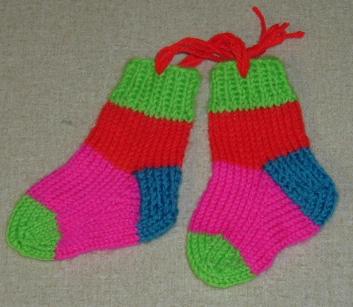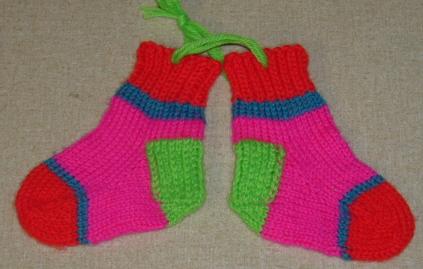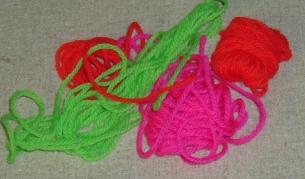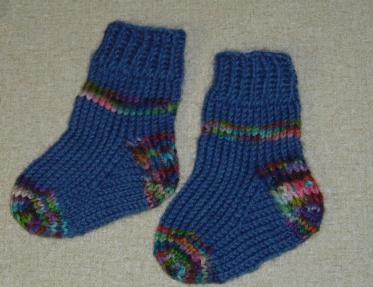What can you make out of 4 "50-gram" skeins of wool? I attempted to find
out. I purchased 4 skeins of machine-washable wool, in the colors red, blue,
green, pink. They are very bright or neon shades, so fun to knit!
I began knitting during a car trip, making up my patterns as I went. I decided it would be easier to just make up the first sock in each pair in order not to have to think about following a set pattern while I was traveling and socializing. I would make the mates after we returned home, when thinking and duplicating was easier! I had plenty of yarn and knew I wouldn't run out of any color.

These are the "Innie-Outie" Socks. The green dots are inset while the pink bobbles stick out. They are top-down, as are almost all of my socks. They began with 32 stitches, and have random widths of stripes.

Stripes came next. Again I used 32 stitches, and each stripe was 6 rows long. The before- and after-heel rows in red equal 12 rows total. Cuff, heel, toe all in one color, stripes were the other colors. I kept the pink away from the red and reversed the order of the stripes on the foot.

I thought I'd make a bunch of fraternal twin socks, socks with the same 4 colors, but which could be mixed up each other. (However, on the third sock, I decided just to go with pairs.) These all began with 28 stitches and have the same row counts so they could be mixed, but they have matching mates. The foot measures 4 inches long.

The second pair.

I followed the same order as before: pink, then green, then red, then blue, then pink.... But with the blue at the heel, the pink was next to the red and I just didn't like it as part of a large set of mix-and-match
socks. Hence, I made mates for each of these.
I now had just hollowed-out skeins of yarn left. Using a digital scale, I weighed the finished socks and the remaining yarn. I was trying to see how big I could make the last pair of socks. The little ones were about 25 grams per pair, the big one about 36 grams.
I was greatly annoyed to find that the total of the socks and left-over yarn did NOT equal 200 grams. Each skein had been short 1-3 grams.
(Tail ends would not account for this.) This is not uncommon, I have
found. (I once took my scale to a yarn shop, and the skeins of a different brand
of wool that I tested were almost all less.) I estimate that the yarn (total of
4 skeins) was short by about 15 yards. That's about 1/6 of a skein. 30 or more
rows of knitting on these little kid socks.

I divided each of the remaining yarn into two bundles of equal length, drawing from both ends of the skeins. I then had 8 mini-balls, 2 each of the 4 colors. I decided to try a toe-up sock so I wouldn't run out. I used 2 sets of dpn, so I did both toes, then both blue stripes, then both pink, and so on. This way, I wouldn't forget what I'd done to the first one before the second was begun.
I started with waste yarn for my beginning stitches (I would Kitchener
the toes afterwards) and increased where I would have decreased coming the other
way. I used a twisted 'make one' increase. I twisted each side in the opposite direction to try for symmetry.
I downloaded some instructions for a heel, but did not like it (the instructions were for an adult sock, and even though I changed numbers, I wasn't happy with the results.) I therefore tried to imagine the opposite of how I usually did a heel. After several attempts, I was satisfied enough to go on. Just don't ask me how I did it, please! I've blotted it out of my memory!

This is all the yarn that remains after these 6 pair of socks (including the yarn used to tie the pairs together, which can be used for darning.)
Conclusions:
1. I knit 6 pair of socks out of 4 "50-gram" skeins of wool. If I had stuck with just the smaller socks, I could have made 7 pair of them.
2. I still prefer cuff-down knitting!
My last pair of CIC socks:

I paired a dark blue wool with food-color-dyed wool yarn. Originally the sock included a puffy all-purl band across the leg, in the variegated. However, after I was finished, I discovered a mistake. (Don't you hate when that happens?!) Yikes! On one the variegated rounds went: K, K, P, P, P, P, K; on the other it was K, P, P, P, P, K, K. The extra K row was at the top on one and on the bottom of the other! Oh no!
Not that it looked different unless you look closer, but I couldn't let it go. I put the uppermost row of blue onto dpn, and removed the variegated rows down to the beginning and just K 3 rows and then wove the next row (Kitchener) to the upper blue row. Therefore, 4 rows of plain knit variegated on the leg.







